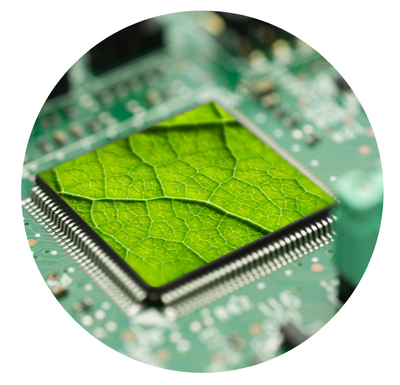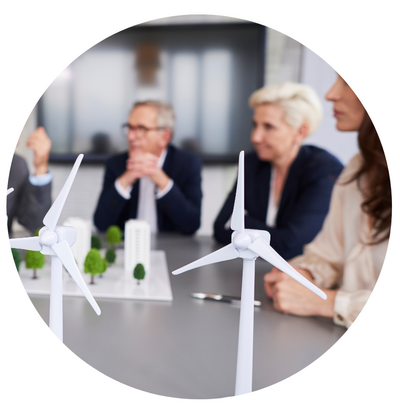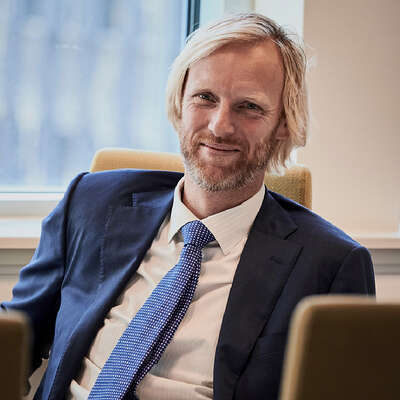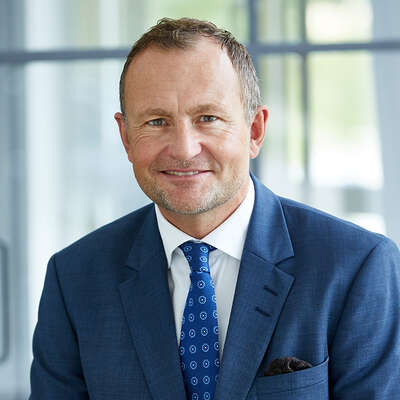Perspectives from Boyden's Renewable Energy Experts
As the grip of COVID-19 continues to have a global impact, Boyden is tapping into the deep collective knowledge base of our partners to bring industry insights and prescriptive learnings to the forefront.
In this issue of Resilient Leadership, Boyden shares the expert opinions of our renewable energy leaders from across the globe: Thomas Zay (United States), Kjetil Haug-Nodeland (Norway), Lisa Pendleton (Australia), Morten Winther (Denmark), Kevin Gormely (Canada), and Allan Marks (Australia).
In conversation with Boyden's Global Industrial Practice Leader, Francesca d'Arcangeli (U.K.), the group explores drivers of renewable energy, transformational shifts, emerging opportunities, evolving consumer values, and the leadership skill set to deliver.
d’Arcangeli: Crisis can be a catalyst for transformation. What shifts and opportunities are arising across renewable energy? Is it region-specific?

Zay: Prior to the pandemic, the trend for de-carbonization of global energy supply chains was already well underway. In my recent conversation with former Chief Commercial Officer at Golar LNG, Robert Carter, we discussed how COVID-19 has resulted in a significant energy resource disruption and reduced demand and investment in coal, oil and natural gas, while renewables have shown a modest increase in energy consumption by almost 1% during the crisis. So, the momentum for continued growth in the renewables sector remains sound. The pandemic provides a watershed opportunity and catalyst for governments and private-sector corporations to reset and re-direct future investments and operational strategies into the sector.
Haug-Nodeland: Yes, that is an excellent point. For example, green stimulus packages had a major impact on support for solar power in Germany after the financial crisis. This was a strong contributor to the fall in the cost of solar power at the beginning of this decade. The size of the crisis packages and the green/fossil focus will vary greatly from country to country and are thus highly specific per region. Europe is generally very far ahead. I would also add that employment and income would be prioritized in a crisis, meaning less focus on energy conversion and more on economic growth, as well as lower economic room to maneuver for green solutions.
I also believe demand destruction might impact the need for new energy and could lower growth expectations. On the other hand, a stronger focus on cost efficiency might give room for renewable energy systems (RES) deployment at the expense of thermal. Finally, stranded projects might be opportunities for other players with more solid economies.
Pendleton: To put this into context from an Australian perspective, Australia has large fossil fuel reserves, including coal. We have had a long history of readily available coal supplies and coal-fired power generation, and in the past, electricity prices were relatively low. This meant that there was not as much impetus for Australia to develop renewable energy generation assets, compared to other countries with fewer fossil fuel resources.
In more recent times, with the growing awareness of climate change and global warming, there has been a shift in consumer sentiment towards renewable energy. However, with flat wages growth across the country and the price of electricity having risen for many households, energy companies are trying to balance the need to supply energy at affordable rates with the desire of both the government and the public to have more renewable energy.
Winther: Although there is a focus on having a footprint in low-cost areas, the pandemic is transforming where you are producing what, and the lead times associated with each project are now considered with a more balanced perspective. This means that nearshoring is also a real consideration. The crisis has influenced the awareness of where the product is produced, and a topic that is often forgotten is disposal after “end of life”. As a wind turbine contains many different materials – e.g. carbon, steel, cast iron, electrical components, copper cables, batteries, glass fibre, epoxy, etc. – the disposal of all components is comprehensive and expensive.
Gormely: In Canada, we are seeing significant innovation around renewable energy and related clean technologies, including solar, wind, tidal power, and clean energy storage – all critical components of a clean economy. In fact, Canada continues to punch above its weight in terms of cleantech innovation with 12 Canadian companies being included in the most recent Global Cleantech 100 – with only the United States having more representation.
d’Arcangeli: Are there any specific trends that can be attributed specifically to each segment: wind, solar and hydropower?

Zay: The renewable energy sector has benefited tremendously from heavy research and development spending leading to significant technological innovation, particularly with solar photovoltaic (PV) systems and wind technologies making it much more cost-competitive with oil, gas, and coal. Taking in Carter's perspective here as well, the cost of utility-scale wind farms has fallen by up to 70% since 2010 and new technologies now allow more energy to be harvested from sites with the same wind speeds. Over the past 20 years, government mandates and production targets in Brazil, the United States, and in the European Union have encouraged the equipment supply side to grow, driving manufacturing economies of scale and further cost reductions. As a result, the price of power offered by utility-scale wind farms and solar PV projects in several countries is now below wholesale power prices from existing non-renewable sources.
Marks: In Europe and the UK, wind has particularly proliferated. In Australia, it is more difficult to implement, although that’s changing. Solar certainly has a lot of applications in construction, with roof tiles going into buildings and other construction materials. This is a sector in which solar is having quite a pronounced impact from a commercial point of view. Hydropower is the one evolving in a big way, generating a lot of excitement as a generic, longer-term renewable solution. That development means it will probably be a more prevalent solution.
Haug-Nodeland: Wind and solar being the least expensive technologies results in these segments growing the most within the power sector worldwide. The cost of wind has halved in the last 10 years, and the cost of solar is down 80% in the same time period. In general, it can also be said that the development of solar power is less controversial than the development of wind – fewer barriers from local resistance, regulatory framework, or grid costs. Solar also has stronger cannibalization effects than wind power. Utility-scale is expected, and end-user tariffs are important for the size of rooftop deployment. Hydropower production, while more expensive to develop with limited opportunities, is often more flexible than wind and solar power and can thus produce the hours with the highest price. In general, it is risky to only rely on income from the wholesale market when the share of RES is increasing. There is a need for auctions or other incentives to secure income for these new projects.
Winther: There is a common trend amongst wind and solar generating power-to-X which means greater opportunities for different cost-efficient storage solutions. Balancing hydropower and wind energy is, and has always been, another way of storing energy in specific geographies. Power-to-X offers the production of synthetic natural gas, which can be used as fuel instead of storing sustainable energy in batteries. This creates a path to a carbon-neutral future and has the potential to decarbonize transportation, industries, and the energy sector while exploiting existing infrastructure.
Also, we see a trend in the wind industry regarding turbine sizes. Right now, the GE Haliade X is one of the most powerful turbines in the world with 12 MW and a 107-meter blade. Siemens is challenging this with a windmill with 15 MW and a 108-meter wing. This trend and these large wind turbines will require a lot from the infrastructure when they are being installed.
d’Arcangeli: Cleantech is accelerating these possibilities and is critical to a green future. What possibilities does next-generation cleantech hold?

Pendleton: In Australia, there will need to be a transition out of the use of fossil fuels, so part of that focus is on how to make energy generation as clean as possible during the transition period.
Government programs have provided rebates for households that install solar power. There is also a strong focus on hydrogen, and how that could be utilised as an energy source. The Council of Australian Governments (COAG) Energy Council has also released a National Hydrogen Strategy to establish Australia’s hydrogen industry as a major global player by 2030.
Zay: Carter and I discussed this at length and concluded that the most exciting cleantech industrial technologies emerging today are renewable gases, like green hydrogen, biogas and biomethane, with carbon capture and CO2 management integrated to yield blue hydrogen from methane reformation processes. It’s a formative time.
Haug-Nodeland: I’d add that further investigation into cleantech business areas such as sector-coupling/electrification, renewable energy, biomass, hydrogen, energy efficiency and carbon capture and storage can create ample opportunity and growth. Within each of these areas, the potential is vast as energy sectors are becoming more inter-linked in the green transition. In addition, new business opportunities will emerge, from reporting on organizational CO2 footprints to transition strategy consulting.
d’Arcangeli: Large multinationals have publicly affirmed their moves towards fully renewable sources. What functional leaders will be in high demand as a result?

Marks: Some of the roles we are starting to see are around sustainability, governance, people who have experience in clean technologies, and in energy orgs. I think we will see a higher demand around corporate affairs, the development and application of technologies and how they can be leveraged. It depends on what the organisation does, but from a stakeholder point of view the biggest thing will be how they engage with communities, so we’re seeing an increase in roles related to stakeholder management.
Gormely: The challenge for most Canadian cleantech companies has not been in R&D or innovation – Canada has been a leader in this regard – it has been the relative inability of these companies to scale and commercialize their technology. This is owing in large part to the relatively small size of the Canadian market, both in terms of demand and availability of domestic sources of capital. For Canadian companies to succeed, they will need access to growth capital to allow them to scale up operations and effectively compete in the global market.
To achieve these goals, Canadian companies will need to ensure that their management teams include business development professionals who have knowledge of and access to key global markets including the U.S., China, India and Europe. Equally important, Canadian cleantech companies, particularly smaller, less-established players, will need to ensure that they are able to access various sources of funding, whether through public markets, private equity, or taking advantage of government incentives. Knowledge of financial markets and appropriate capital funding sources will be critical to scaling operations and competing globally.
Haug-Nodeland: New sought-after leadership attributes and skills are emerging, for example having credibility and dedication in relation to the company's climate goals and acting as a motivator across the workforce. McKinsey has conducted studies in this area, indicating that one of the reasons why companies that invest in ESG do better than others is due to a boost in employee motivation, resulting in a productivity uplift. Several other emerging attributes include bold decision making, being the first mover, and not waiting too long since the market is in fast transition. A holistic approach is also valuable. A leader with this attribute has the ability to comprehend the full picture – market players, competitors, market development, employee capabilities – and trace it back to their own role. Another is the ability to use your analytical competence in the energy market, or that of others, to create value. Finally, someone with an agile attitude will be able to learn from others and adapt quickly.
Winther: Companies are now requested for a green footprint. This goes for every aspect of their business – procurement, manufacturing, energy supply, transportation, etc. We have seen big companies like Google, Facebook, and others working with a 100% energy supply from renewable sources. That leads me to believe that the Chief Sustainability Officer role will be playing a more significant role in companies. The role will be critical in securing that the company meets its goals for transferring into a renewable future and meeting ESG objectives. The essence of the role will be to have a full mandate from the top management to put actions behind the objectives and ambitions of the company. Especially because the position of the CSO has been argued as being symbolic. I also think that the CSO role will be closely interacting with the full value chain of the company. Within sales, the sustainability area will be a key driver, not only in differentiating the company but also in illustrating that the company is actually putting its thoughts into action.
d’Arcangeli: How do these shifts tie in with evolving consumer values and priorities?
Haug-Nodeland: There is visible change in the direction of the consumer’s desire for sustainability. One interesting effect is that astute suppliers are getting ahead of expectations and producing sustainable products and services even before their core consumer base demands it. Consumers certainly influence the green and clean shift through actions such as voting preferences, supporting green businesses, through their investments, and where they choose to work. Of course, governmental and regulatory focus towards green transition will support business activities in that direction.
Gormely: Without a doubt, we have seen an increased awareness of the impact of fossil fuel production and use on climate change. Even within those regions of Canada that are most dependent on the oil and gas industry, there is growing recognition in Canada that we must transition to a low-carbon economy. As with other developed countries around the world, the demand for renewable energy is largely being driven by consumers, and voters, who are pressuring governments to develop policies and programs to both incentivise the development and use of renewable energy and cleantech technologies and to eliminate subsidies to the fossil fuel industry.
Pendleton: Over the past five years, there has been a clear shift in Australia towards renewable energy and constraining carbon emissions, and this is being addressed in government policy and through the development of renewable generation assets such as wind farms.
Consumer education at this point is essential. People need to understand the associated costs and impacts of the development of renewable generation assets. This includes how we can continue to ensure security of our energy supply at an affordable cost. The average consumer would generally support renewable energy, but there appears to be a gap in understanding in regard to the capital cost and other impacts on the community of building up that asset base.
d’Arcangeli: Supply chains have experienced severe disruption. What might a sustainable supply chain strategy look like?

Marks: There are several ways to consider this issue. One main approach, on a macro scale, is the prevalence of a more local supply chain rather than global. That would mean taking a close look at where products are sourced from, where they are assembled, and how they are delivered. At the local level, there is more focus around emissions, recycling and recycled packaging, using fewer emissions in getting goods from A to B, using more digitised applications, better use of space and energy to generate information, and being more technology driven, which is less people-dependent and consumes less energy and space. If we start to look at how products are transported and the forms of energy used, e.g. electric vehicles potentially, battery-charged applications for movement of goods, shorter distances, there is potential to see savings there.
Haug-Nodeland: A good starting point is proper collaboration and internal integration, with good business ethics and focus on corporate social responsibility. There needs to be inclusion of environmental concerns globally, in terms of GHG emissions, and locally, such as protection of nature/communities . In terms of technology, more predictability is important. For example, it will be important for a battery factory to have secured a large part of the production of batteries before manufacturing to reduce the risk of new and even better batteries coming on the scene and preventing the factory from selling its "old" technology.
d’Arcangeli: Many leadership lessons will be learned from the pandemic. What do you feel will be one of those top lessons?
Winther: Adaptability and agility. Having a clear vision and clear strategies are all very important issues but the pandemic has certainly taught us that flexibility and adaptability are absolutely necessary competencies in future leadership.
Haug-Nodeland: Yes, the need to be agile stands out. And the need to understand impacts externally, in energy and power markets, and how to adapt the business. Also critical are clear governance principles and an efficient way of managing, i.e. clear communication, transparency in plans, and actions taken. Finally, factoring the need to connect your teams socially, and adapting those methods to any new work environment.
Gormely: There are so many leadership lessons to be learned. First, leaders need to demonstrate authentic and active appreciation for the personal and professional challenges that team members may be experiencing. They need to be ready to provide support: emotional, financial where possible or otherwise to ensure the wellbeing of those employees. Second, COVID-19 has shown us that there are new ways of working – that the concept of working in an office from 9 to 5 does not work for all employees and may be impacting an organization’s ability to attract and retain top talent. Finally, regardless of industry, the pandemic has demonstrated the importance of having a disaster recovery plan. Organizations that were prepared for disruption have generally transitioned to a remote working environment more successfully than those that were caught flat-footed.
Pendleton: One of the things that took everyone by surprise was the fact that Australia’s internal state borders closed during COVID-19. That thought would have been inconceivable in the past, and it has given rise to some significant challenges. For example, a client shared that its field service technicians were unable to fulfil maintenance contracts as they could not cross state borders.
One of the key learnings from a leadership perspective will be how to build into their crisis management plan the possibility that they might not physically be able to get people on-site or access specialist services as they could before. New contingency plans to address these issues will need to be put in place.









